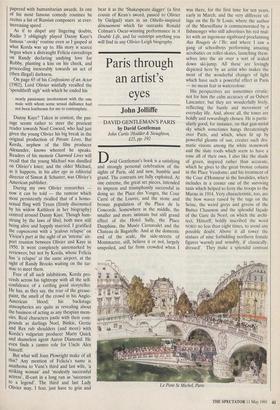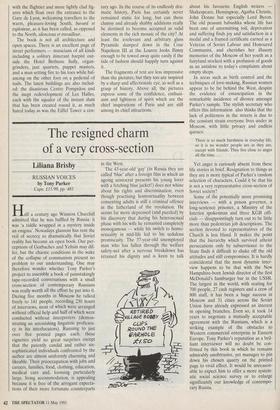Paris through
an artist's eyes
John Jolliffe
DAVID GENTLEMAN'S PARIS by David Gentleman John Curtis /Hodder & Stoughton, £25, pp. 192 David Gentleman's book is a satisfying and strongly personal celebration of the sights of Paris, old and new, humble and grand. The contrasts are fully exploited. At one extreme, the great set pieces, intended to impress and triumphantly successful in doing so: the Place des Vosges, the Cour Cane of the Louvre, and the stone and bronze population of the Place de la Concorde. Somewhere in the middle, the smaller and more intimate but still grand effect of the Hotel Sully, the Place Dauphine, the Musee Carnavalet and the Chateau de Bagatelle. And at the domestic end of the scale, the side-streets of Montmartre, still, believe it or not, largely unspoiled, and far from crowded when I was there, for the first time for ten years, early in March; and the very different vil- lage on the Ile St Louis, where the author of the Marseillaise is commemorated by a fishmonger who still advertises his red mul- let with an ingenious signboard proclaiming Aux Rougets de l 'Ile; and where I saw a gang of schoolboys performing amazing acrobatics on roller-skates, launching them- selves into the air over a sort of scaled down ski-jump. All these are lovingly depicted here by an artist who makes the most of the wonderful changes of light which have such a powerful effect in Paris — no mean feat in watercolour.
His perspectives are sometimes erratic: not for him the calm accuracy of an Osbert Lancaster; but they are wonderfully lively, reflecting the bustle and movement of everyday life. And, above all, the tones are boldly and rewardingly chosen. He is partic- ularly good, for instance, on that gun-metal sky which sometimes hangs threateningly over Paris, and which, when lit up by powerful gleams of sun, creates such dra- matic visions among the white stonework and the slate roofs which seem to have a tone all of their own. I also like the shade of green, inspired rather than accurate, which he gives to the great bronze column in the Place Vendome; and his treatment of the Cour d'Honneur in the Invalides, which includes in a corner one of the surviving taxis which helped to ferry the troops to the Marne in 1914. Very characteristic, too, are the bow waves raised by the tugs on the Seine, the weird greys and greens of the Buttes Chaumon and the splendid façade of the Gare du Nord, on which the archi- tect, Hittorff, boldly inscribed the word NORD no less than eight times, to avoid any possible doubt. Above it all tower the statues of nine forbidding northern female figures 'warmly and sensibly, if classically, dressed'. They make a splendid contrast Le Pont St Michel, Paris with the flightier and more lightly clad fig- ures which float over the entrance to the Gare de Lyon, welcoming travellers to the warm, pleasure-loving South, bavard et exploiteur, as it has been called, as opposed to the North, silencieux et travailleur.
The book is not all architecture and open spaces. There is an excellent page of street performers — musicians of all kinds including a solitary itinerant harpist out- side the Hotel Bethune Sully, organ- grinders, jazz quartets, puppet masters, and a man setting fire to his toes while bal- ancing on the other foot on a pedestal of nails. The latest buildings are also includ- ed: the disastrous Centre Pompidou and the inept redevelopment of Les Halles, each with the squalor of the instant slum that has been created round it, as much hated today as was the Eiffel Tower a cen- tury ago. In the course of its endlessly dra- matic history, Paris has certainly never remained static for long; but can these clumsy and already shabby additions really be destined to become accepted as valid elements in the rich mosaic of the city? At least the irrelevant and arbitrary glass Pyramide dumped down in the Cour Napoleon III at the Louvre looks flimsy enough to be towed away quite easily if the tide of fashion should happily turn against it.
The fragments of text are less impressive than the pictures, but they too are inspired by a sharp and affectionate eye, as well as a grasp of history. Above all, the pictures express some of the confidence, enthusi- asm and lightness of spirit which are the chief inspirations of Paris and are still among its chief attractions.



























































 Previous page
Previous page